Stadium Size, Football Droppers, and Deemphasizers: Wichita State
Wichita State has an interesting football history, with two of its better-known moments occurring in 1905 when the school was known as Fairmount University. One involved an early night game, which some claim to be the first night game west of the Mississippi, although it wasn't, as two Drake-Grinnell Games preceded it. Still, it was the only game I know of in which the lighting came via Coleman lanterns rather than electrical lights.
Fairmount is also known for playing on Christmas Day 1905 in a test game assessing proposed new rules, including forward passing.
The City of Wichita acquired Fairmount in 1926, renamed it Wichita University, and then transferred it to the state of Kansas in 1964, when it became Wichita State University.
Through World War II, Wichita primarily played other Kansas schools that now compete in DII or NAIA football. They played the big boys on occasion, including a 1938 loss, 32-0 at West Point, and regularly won their small college conference.
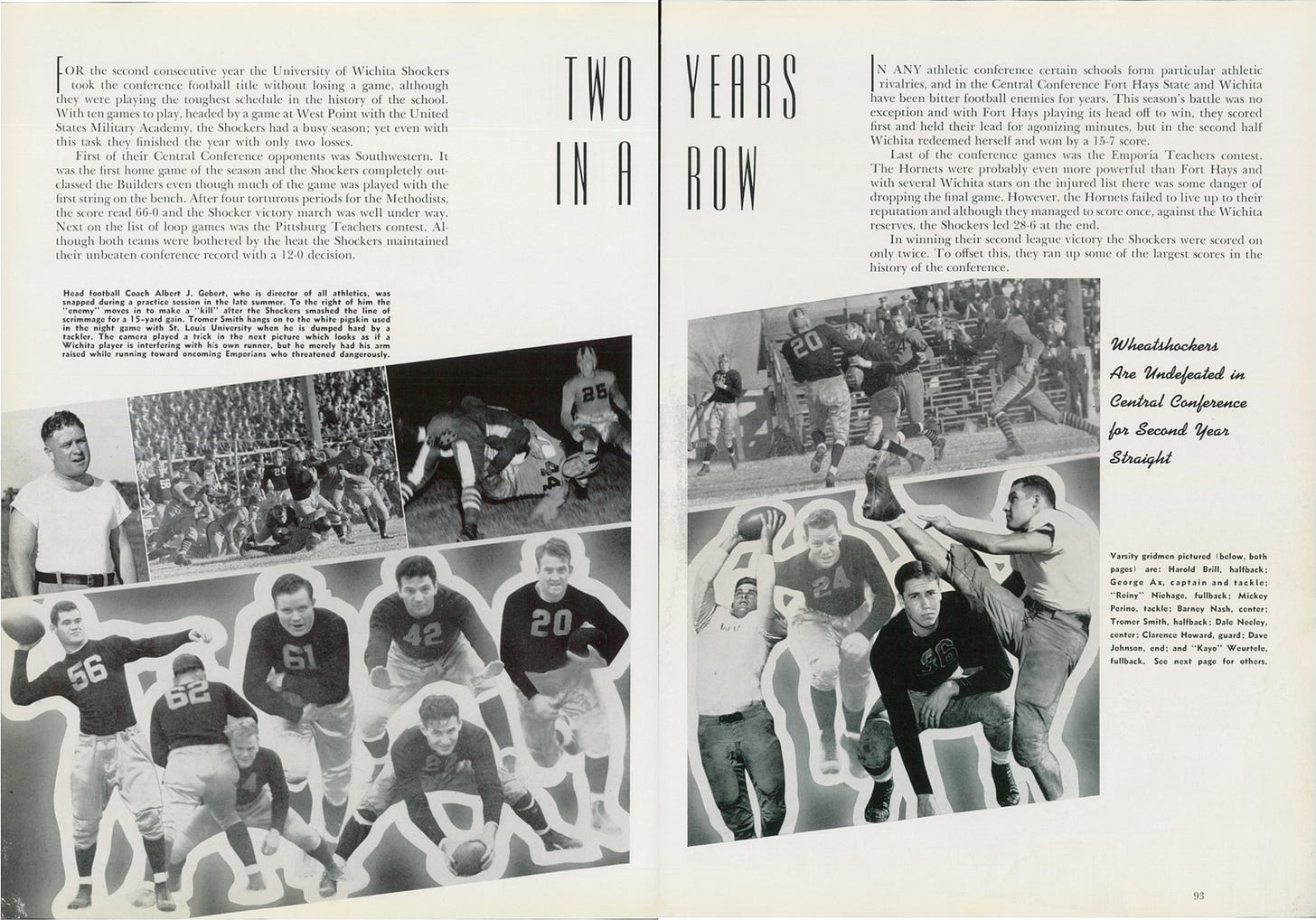
They stepped up to join the Missouri Valley Conference in 1946, a league that lacked stability, with several members dropping football, leading an increasingly weak league.
Wichita broke ground in 1941 on a new stadium to be built in stages as money became available. Due to metal shortages during World War II, the first phase was completed in 1946. A later addition increased capacity from 16,000 to 31,500, but it dropped to 24,000 in 2002. The stadium is currently undergoing a phased demolition and reconstruction as the school replaces its football venue with one designed for track and field.
The Shockers were never particularly good at big-time football, enjoying only three winning seasons from 1962 through 1986. The losing tradition contributed to the challenge of attracting fans, as many locals cheered for Kansas or Kansas State, neither of which was very successful either. Questions about the program's financial viability regularly surrounded the program.
The program and community took another hit in early October 1970 when one of two team planes traveling to Utah State crashed, killing 31, including 14 team members, their head coach, and the athletic director. Despite it all, the team voted to continue playing. Two weeks later, they met #9 ranked Arkansas, losing 62-0, though Arkansas reserves played much of the game and Razorback fans cheered for the Shockers throughout. The team finished the season with an 0-9 record.
Wichita State became the first predominantly-white Division I-A school to hire an African-American as head coach in 1979. Willie Jeffries stayed through the 1983 season, but recruiting violations during his tenure led to his dismissal. Ron Chismar, who would prove to be the Shockers' last head coach, took his place.
The Shockers went 2–9 in 1984 and 3–8 in 1985. Despite the consistent struggle, Wichita State's promotional team put their best foot forward in 1986, touting the future and potential of the previous year's freshmen class, many of whom had redshirted, as well as the current year's JUCO signees.
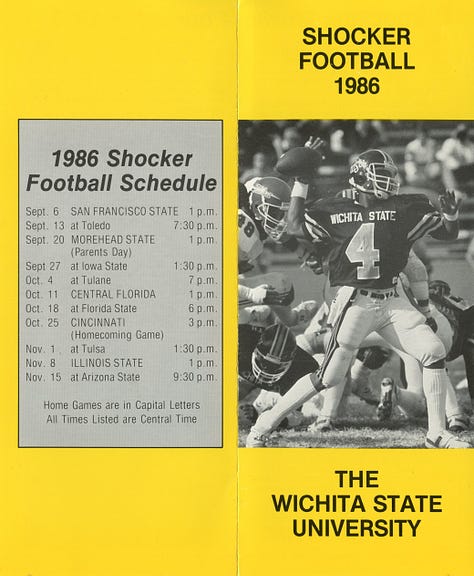
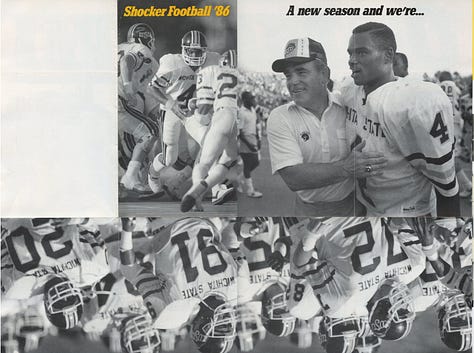
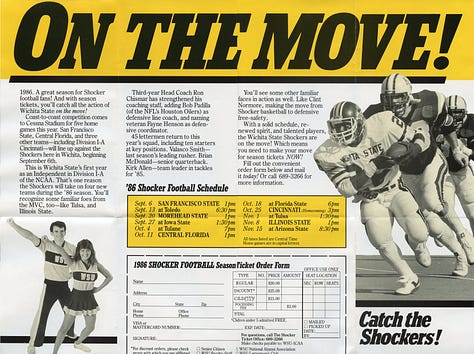
Still, before the 1986 season, the school engaged a consulting firm, Synergos, to study the program. The sports consulting industry was in growth mode at the time, spurred by increased merchandise licensing, expanded television coverage, and a new NCAA requirement that programs periodically evaluate themselves. The study included numerous stakeholder interviews, so people had to be aware that something was going on.
Following the 3-8 season, during which they beat San Francisco State, Tulane, and UCF while averaging fewer than 10,000 fans per home game, the school president pulled the plug. The school did not have the deep pockets to absorb $800,000+ in football losses each year, so they closed up shop, allocating their limited football dollars to other sports.
Next up: Tampa
Ranking by Stadium Size
Below are the schools reviewed to date, ranked by stadium size. The stadiums' opening and demolition years (if applicable) are also noted.
Wichita State (Cessna Stadium): 31,500 | 1946 - 2022
Catholic (Brookland Stadium): 30,000 | 1924 - 1985
Denver (DU/Hilltop Stadium): 30,000 | 1925 - 1971
Marquette (Marquette Stadium): 24,000 | 1924 - 1977
Xavier (Corcoran Stadium): 15,000 | 1929 - 1988
Gonzaga (Gonzaga Stadium): 12,000 | 1922 - 1949
California State University, Fullerton (Titan Stadium): 10,000 | 1992 - TBD
Boston University (Nickerson Field): 10,000 | 1915 - TBD
Vermont (Centennial Field): 10,000 | 1923 - TBD
St. Mary's (St. Mary's Stadium) 5,500 | TBD
NYU (Ohio Field): 5,000 (est.) | 1897 - 1947
San Francisco (St. Ignatius Stadium): <5,000 (est.) | c. 1909 - c. 1930
Carnegie-Mellon (Skibo Bowl): 4,500 | 1960 - 1987 | Gesling Stadium: 3,900 | 1990 - TBD
Sewanee (McGee Field): 3,000 | 1891 - TBD
Long Beach State (none): 0 | Not applicable
Schools to Review
California State Santa Barbara | Case Western | Chicago | Creighton | DePaul | Detroit | Drake | Loyola (Chicago) | Pacific | St. Louis | Santa Clara | Tampa | Washington University in St. Louis
Click Support Football Archaeology for options to support this site beyond a free subscription.



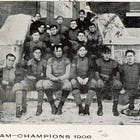
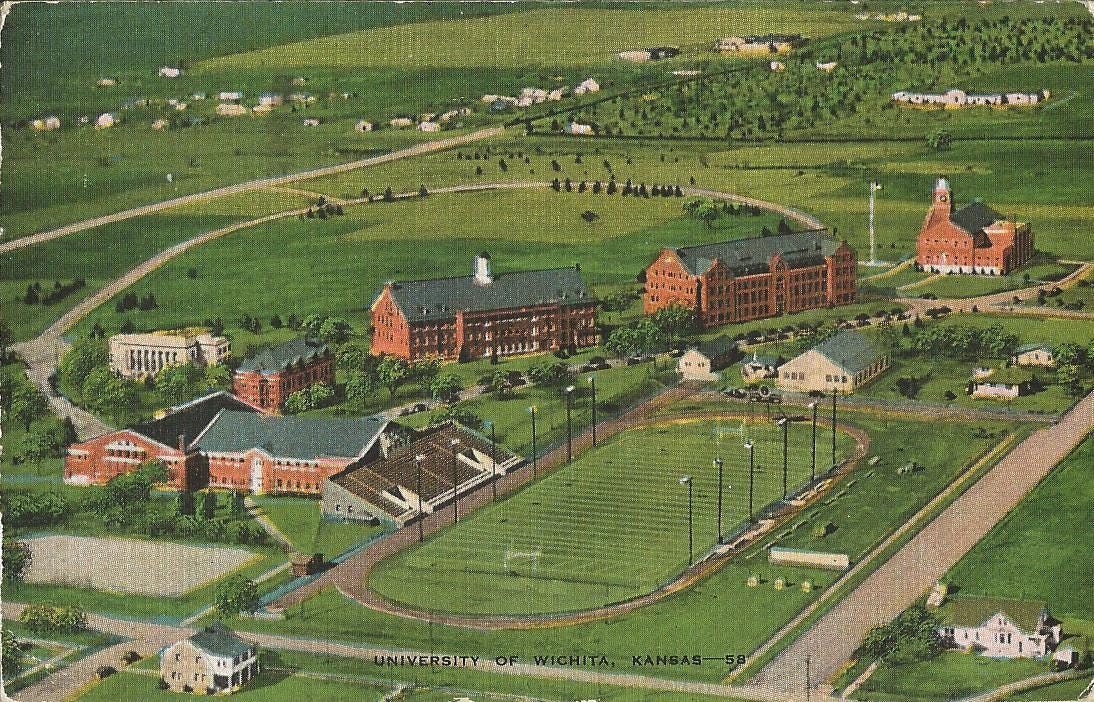

Bill Parcells is Wichita’s most famous football alumnus.
It’s also the school that Ted Lasso “coached” before heading over to the UK to coach soccer!